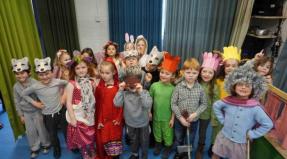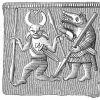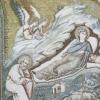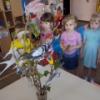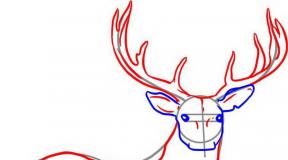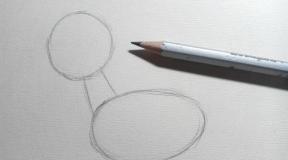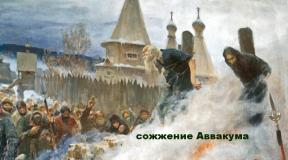The technique of using mnemonics in speech therapy. Mnemonics in speech therapy classes. in speech therapy classes
Methodical piggy bank
Mnemonics or mnemonics [Greek. mnemonika art of memorization] is a system of methods and techniques that ensure effective memorization, preservation and reproduction of information through the formation of artificial associations.
A mnemonic table is a schema that contains certain information. The bottom line is as follows: for each word or small phrase, a picture (image) is invented; thus, certain text is sketched. After that, the child from memory, using a graphic image, or a reference picture, reproduces the entire text.
 Recommendations for the use of mnemonic tables in working with preschoolers
Recommendations for the use of mnemonic tables in working with preschoolers
"We teach children to make riddles"
Mystery- one of the small forms of oral folk art, in which the most vivid, characteristic features of objects or phenomena are given in an extremely concise, figurative form. Guessing and thinking up riddles has an impact on the versatile development of children. By inviting children to guess and memorize a riddle, we activate the child's thinking, memory, imagination and, of course, stimulate speech development. The manual contains riddles and mintables to them.
Mnemonic tables for retelling
Herringbone
The summer is over. The trees are dressed up in autumn outfits. The green leaves of the white birch have turned yellow. The maple tree adorned itself with yellow and red leaves. And the mountain ash put on a bead made of red berries. Only the tree has not changed its green needles.
“My outfit is not ready yet,” said the tree. It will only be ready for the New Year.
L.N. Efimenkova

Scared
Masha lived in her grandmother's house in the summer. One day she went to the forest to pick mushrooms. Suddenly a gray wolf looked out from behind a tree. "Ouch!" - Masha screamed and was about to cry. But suddenly the gray wolf barked and wagged its tail. "Yes, this is our dog - Sharik!" - Masha was delighted.
L.N. Efimenkova
Brave puppies
There were two puppies. They went out into the yard. The puppies looked at the sky and saw a yellow shiny circle. Puppies are watching, they do not know what it is. The puppies were scared.
- Let's bark, says one puppy
“Come on,” the other puppy agreed.
Puppies barked. And the circle rises higher and higher.
- I was scared! - the first puppy is happy.
- Runs away! says another puppy.
Puppies barking merrily
according to M. Petrov

Animal dispute
A cow, a horse, a dog argued among themselves which of them the owner loves more.
“Of course, me,” the horse says. -I bring him firewood from the forest. He himself rides me to the city: he would have disappeared without me completely.
“No, the owner loves me more,” says the cow. -I sing milk to his family.
“No, me,” the dog grumbles. -I guard his house.
The owner heard this and says:
- Stop arguing in an empty way. I need all of you and everyone is good in their place.

Bimka
In one big, beautiful house there was a Bimka puppy. One day he climbed under the fence and ended up in the forest. Here he met a hedgehog. Bimka touched him with his paw - it pricks! Suddenly Bimka saw a butterfly - variegated, airy - and ran after it. I ran and ran and got lost. Bimka looks - there is a dark forest around and the house is not visible. Suddenly he hears: “Bimka! Bimka! " This was running and shouting Dimochka, his master. The boy stroked the puppy, picked him up and carried him home.
T.A. Tkachenko
Mnemonics - speech therapist assistant in correctional work
with preschoolers with general speech underdevelopment (from work experience).
T.Yu. Mironov,
JV GBOU SOSH No. 4 Chapaevsk - d / s No. 20,
teacher speech therapist.
It is known that the defective speech activity of children with OHP leaves an imprint on the formation of their sensory, intellectual and affective-volitional sphere. They have insufficient stability of attention, limited opportunities for its distribution. With a relatively preserved semantic, logical memory in children with OHP, verbal memory is reduced, and the productivity of memorization suffers. They forget complex instructions, elements and sequence of tasks.
Mnemonics(from the Greek. mnemonikon - the art of memorization) - a technique that facilitates memorization and increases the amount of memory through the formation of artificial associations. At first glance, pictures that are not connected with each other are connected into a plot, and signal schematic images help to activate thought and mnestic processes, allowing the child to remember and even recite a small poem in a few minutes. A feature of mnemonics is the use of symbols, not images of objects. Symbolism is typical for children's drawing in preschool age and does not cause difficulties in the perception of mnemonic tables.
Mnemonic tables serve as didactic material in such types of work on the development of speech:
automation of sounds in pure twisters, tongue twisters and poems;
enrichment of the vocabulary, the formation of practical word formation skills;
development of the grammatical structure of speech.
Mnemonic tables for automating sounds
The process of teaching preschoolers with speech disorders takes a long time and takes a lot of effort, both for the child and the speech therapist. Gradually, the child loses interest in classes, loses the motivation to say “beautifully and correctly”. The problem of motivation is one of the central ones in speech therapy work. To interest, captivate and achieve results is the dream of every teacher. Using traditional methods of correcting speech, I always remember that preschool age is the age of figurative forms of consciousness, and the main means that a child masters at this age are figurative means: sensory standards, various symbols, signs, visual models.
I agree with the author of the article of the "Speech therapist" magazine Barsukova EL that mnemonics can be effectively used at the stage of sound automation. The author of this article uses mnemonic tracks of pure phrases and poems in his work. Barsukova E.L. mnemonic tracks of poems, I successfully use in individual and subgroup lessons on the automation of sounds.
I will give an example of automating the sound "sh" using mnemonic tracks.
Pure phrases
SHA-SHA-SHA - our Dasha is good,
SHI-SHI-SHI - Misha and Masha - kids,
SHE-SHE-SHE - mice in a hut,
SHO-SHO-SHO - I say well!
ASH-ASH-ASH - Natasha has a pencil,
OSH-OSH-OSH - Antoshka has a knife,
USH-USH-USH - the baby goes to the shower,
YSH-YSH-YSH - a mouse in the reeds.

Poem
Cat in the window
Sews a pillow
Mouse in boots
The hut is sweeping.

Patter
A hat and a fur coat, here he is our Mishutka.

Mnemonic tables to enrich vocabulary and develop word formation skills
Mnemonics techniques are also effective in correcting the lexical and grammatical aspect of speech. In the normal course of speech development, the preschooler spontaneously assimilates many word-formation models that simultaneously exist in the language and work within the framework of a certain lexical topic. Children with general speech underdevelopment require special training, and then long training exercises to master word formation skills. Mnemonic tables will help to facilitate this process, diversify it and make it more interesting for the child. Mnemonic tables imply the formation of skills to analyze linguistic material and synthesize linguistic units in accordance with the laws and norms of the language. They allow the child to become aware of the sound of a word, practice the use of grammatical forms, they also contribute to the expansion of vocabulary, the formation of linguistic flair.
To organize correctional work in this area, I use various didactic games and manuals.
Formation of related words

Such mnemonic tables help children with general speech underdevelopment to understand and analyze various ways of word formation. Working with them, children begin to independently perform similar tasks much faster.
Game "Family of words"
Purpose: consolidation of skills in the formation of related words.
Content: The house in which the words "live" is hung on the board. The windows in this house are made of transparent film and behind each one of the symbols is hidden (a large word (big mountain) - for example, fish; a small, affectionate word (small slide), for example, a fish; a sign word (wave), for example, fish ; word-action (two horizontal stripes), for example, fishing; a word that is spoken when there is a lot of someone or something (three rectangles), for example, a fish; word is a person (little man), for example, a fisherman, a fisherman) ... Children receive pictures depicting, for example, a large fish, a small fish, fish soup, a fishing rod, several fish, a fisherman, and settle them in the necessary apartments, forming related words.

Mnemonic tables for the development of the grammatical structure of speech
Concordance of noun and numeral

Concordance in gender, number and case
I see who(what)?
I'm singing about who
(about what)?
I will give to whom
(what)?
I am friends with whom
(with what)?
V 
the area of these pictograms is used to arrange any subject pictures. The speech therapist asks the children to compose a phrase based on a pictogram and an object picture (for example: I see a butterfly; I sing about a butterfly, I will give a butterfly, I am friends with a butterfly).
Lotto "Prepositions"
Purpose: consolidation of the ability to use prepositions in speech.

Carousel game
Target : change of verbs of the past tense by gender, agreement of words in a sentence, consolidation of the structure of a simple sentence.
Content : two circles (one smaller than the other) are connected in the center so that the small circle can be rotated. Symbols of actions are drawn on the large circle, on the small one - people, animals, and man-made objects. The speech therapist calls the action, the children rotate a small circle, choosing about whom or what they will make a sentence about, and make sentences like: The boy was drawing a tree. Etc.

The use of mnemonic techniques in speech therapy work gives a positive result. In preschoolers with general speech underdevelopment, a sense of interest and responsibility increases, satisfaction with the results of their work appears, mental processes such as memory, attention, thinking are improved, which has a positive effect on the effectiveness of correctional work.
Bibliography:
Barsukova E.L. Automation of sounds using mnemonic tracks. // Speech therapist № 5, 2009.
L.V. Omelchenko The use of mnemonic techniques in the development of coherent speech. // Speech therapist 2008, no. 4, p. 102-115.
Polyanskaya T.B. Using the method of mnemonics in teaching storytelling for preschool children. SPb., 2009.
Rastorgueva N.I. Using pictograms to develop word formation skills in children with general speech underdevelopment. // Speech therapist. 2002, No. 2, p. 50-53.
Site materials http :// festival .1 september . ru (Authors: Ivanova O.V., Lakomykh S.M., Emelyanova N.I.)
from work experience
Vereshchagina E.V. speech therapist
first qualification category
MDOU "Kindergarten No. 18
combined type "Buzuluk
Orenburg region
In our kindergarten, speech therapists use innovative technologies in corrective work with children. One of the techniques of the latest technology is mnemonics.
Mnemonics– it is a set of rules and techniques that facilitate the process of memorizing information.
Mnemonics helps in the development of:
related speech;
associative thinking;
visual and auditory memory;
visual and auditory attention;
imagination;
accelerating the process of automation and differentiation of the delivered sounds.
We begin to use the techniques of mnemonics in classes with young children. To develop certain skills and abilities in children, we introduce mnemonic tables of nursery rhymes into the learning process.
Learning to dress according to the mnemonic table

The essence of mnemonic diagrams is as follows: for each word or small phrase, a picture (image) is invented; thus, the entire text is sketched. Looking at these diagrams, the child can easily reproduce text information.
Gingerbread man ((l), (l,))
Two hands ((p), (p,)) 
Like the article? Tell your friends!
The MDOU has correctional and speech therapy groups. Children with speech pathology have the following problems: poor vocabulary, inability to coordinate words in a sentence, violations of sound pronunciation. Most children have impaired attention, imperfect logical thinking. It is necessary to teach children to express their thoughts coherently, consistently, grammatically correctly, to talk about various events from the life around them, to automate and differentiate the sounds set. It is especially important to develop visual-figurative thinking.
KD Ushinsky wrote: "Teach a child some five words unknown to him - he will suffer for a long time and in vain, but associate twenty such words with pictures, and he will learn them on the fly." Since preschoolers master the visual material better, the use of mnemonic tables in the classroom for the development of coherent speech allows children to more effectively perceive and process visual information. The use of mnemonic diagrams helps the child to enrich a coherent statement.
To teach children to compose stories-descriptions in the work of speech therapists in kindergarten, the computer program "Learning to Speak Correctly" is used with the use of mnemonic diagrams. The use of the material of the program facilitates the perception of visual images, which are a tool for memorizing and reproducing text. The use of a computer program concentrates attention, captivating children, and turns the activity into a game.

At individual speech therapy lessons on the automation and differentiation of sounds, in working with children, it is noted that for an accurate repetition of a poetic text, tongue twisters, a schematic representation of individual parts is sufficient. As practice shows, the use of the mnemonic system allows you to speed up the process of automating and differentiating the sounds set, facilitates memorization and subsequent reproduction of a holistic image in rhymed form.
 According to the results of speech therapy monitoring of groups in our kindergarten, children showed positive dynamics in mastering the correct sound pronunciation, accelerating the timing of the automation of sounds. The volume of visual and verbal memory increased noticeably, the distribution and stability of attention improved, and mental activity became more active.
According to the results of speech therapy monitoring of groups in our kindergarten, children showed positive dynamics in mastering the correct sound pronunciation, accelerating the timing of the automation of sounds. The volume of visual and verbal memory increased noticeably, the distribution and stability of attention improved, and mental activity became more active.
Mnemonics in speech therapy classes. Teaching students with disabilities to write descriptive stories is a very important aspect of their development. Pedagogical experience shows that the process of developing the ability to describe an object in children is very slow. Therefore, in my practice I use one of the techniques that greatly facilitates memorizing poems and composing stories - this is mnemonics. Mnemonics is a system of various techniques that facilitate memorization and increase the amount of memory through the formation of additional associations. Such techniques are especially important for children with disabilities, since mental tasks are solved with the predominant role of external means, visual material is assimilated better than verbal. A child with speech impairment is observed - insufficient vocabulary, poorly formed grammatical structure of speech, inability to construct a monologue, poor diction. Mnemonic tables serve as didactic material in the work on the development of coherent speech of children, to enrich the vocabulary, when learning to compose stories, retellings, guessing riddles, memorizing poetry. The goal is to develop visual and auditory memory, to activate the dictionary on a specific lexical topic. When using visual modeling in their work, it teaches children: to get information, make comparisons, draw up a clear internal plan of mental actions, speech utterance; formulate and express judgments, make inferences; the use of visual modeling has a positive effect on the development of non-speech processes: attention, memory, thinking. The use of reference pictures for learning to memorize poems captivates students, turns the lesson into a game. This method is most effective for students with disabilities. The visual image preserved by the child after listening, accompanied by viewing the drawings, makes it possible to memorize the text much faster. Within the framework of the Federal State Educational Standard, the use of mnemonics in the educational process allows the integration of several educational areas: speech, social - communicative, artistic aesthetic, and cognitive development. Using mnemonic tables in speech therapy classes to correct reading and writing, students make statements clearer, coherent and consistent. The students had a desire to retell fairy tales, texts, to come up with interesting stories - both in class and in everyday life. The active and passive vocabulary is also expanding. The peculiarity of the technique lies in the fact that not images of objects are used, but symbols, which makes it much easier for students to find and memorize words, since the symbols are as close as possible to speech material. The child's ability to accurately describe an object contributes to the improvement of his speech, thinking, facilitates the process of information exchange. In my practice, I use reference schemes to compose descriptive stories from Internet resources.
From the experience of a speech therapist teacher at a preschool educational institution
Content1. Explanatory note
2. Relevance of the project
3. Goals and objectives of the project
4. The main part.
4.1. The concept of mnemonics, visual modeling, techniques of mnemonics methods
4.2. Stages of using mnemonic tables
4.3. Descriptive stories
4.4. Using mnemonic tables when learning a poem
4.5. Learning to retell
4.6. Drawing up stories based on a plot picture
4.7. Stages of working with a schematic model
4.8. Stages of work on mnemonic tables
5. Results
6. Application
7. Long-term plan
Introduction
“Teach your child with some unknownfive words to him - he will suffer for a long time and in vain,
but associate twenty such words with pictures,
and he will assimilate them on the fly. "
K. D. Ushinsky
1. Explanatory note
The main idea of the project is to use models-symbols, mnemonics that help speech therapists in their work in the formation of cognitive and speech development in children with severe speech impairments. The proposed material describes the main theoretical provisions on which the project is based.
In preschool childhood, the child has to solve more and more complex and varied problems that require the isolation and use of connections and relationships between objects, phenomena, actions.
With the development of curiosity, the cognitive interests of the thinking of children, their mastery of the world around us, we increasingly resort to using models, schemes, mnemonic tables, etc. The child sets himself cognitive tasks, seeks explanations for the phenomena noticed, discusses them and draws conclusions.
Today - figurative speech rich in synonyms, additions and descriptions in preschool children is a very rare phenomenon. There are many problems in the speech of children.
Therefore, pedagogical influence in the development of speech of preschoolers is a very difficult matter. It is necessary to teach children to express their thoughts coherently, consistently, grammatically correctly, to talk about various events from the life around them.
The modeling is based on factors that facilitate the process of becoming coherent speech.
One of these factors, according to S. L. Rubinstein, A. M. Leushina, L. V. Elkonin, and others, is clarity. Examination of objects, pictures helps children to name objects, their characteristic features, actions performed with them.
As a second auxiliary factor, we will single out the creation of a plan of the utterance, the importance of which was repeatedly pointed out by the famous psychologist L. S. Vygotsky. He noted the importance of sequential placement in the preliminary scheme of all specific elements of the utterance.
For many years of my work, I have been using modeling techniques in classes with middle and older children. age. This technique is effective in the formation of LGS, coherent speech, in the automation of sounds. The duration of the application depends on the topic and purpose of the lesson. For example, when developing coherent speech, you can build a lesson on only one modeling method. and with automatic sounds only partially. This develops not only the child's speech, but also ensures the successful mastering by children of knowledge about the features of natural objects, about the world around them. Here comes the effective memorization of the structure of the story, the preservation and reproduction of information.
2. Relevance of the selected project:
Over the past decades, the speech pathology of schoolchildren has sharply increased. The acuteness of the problem lies in the fact that children with insufficiently formed oral speech are not ready to start school.
One of the urgent tasks of preschool education is the development of children's speech competence, that is, the ability to solve problems associated with the use of speech as a means of communication. One of the means of forming speech competence is the method of modeling.
In preschool age, visual-figurative thinking prevails, and the replacement of verbal abstract images with visual ones greatly facilitates the teaching of fluency in the native language.
Mnemonics makes it easier for children to master coherent speech;
Applications of mnemonics - the use of generalizations allows the child to systematize his direct experience;
The child, relying on memory images, establishes cause-and-effect relationships, draws conclusions.
Currently, the problem of the development of speech is becoming especially relevant. The main and distinctive feature of modern society is the replacement of live human communication with dependence on a computer. Lack of communication between parents and their children, ignorance of speech difficulties, only increases the number of preschoolers with speech impairments. There are many problems in the speech of children.
Currently, there are various techniques and methods for the development of speech-thinking activity of children.
3. Realizing this topic, I set myself the tasks of the project:
Help children in organizing and organizing cognitive information about the environment;
Enrich the vocabulary of children, develop coherent speech;
to teach consistency, consistency, completeness and coherence of presentation;
Remove speech negativism, educate children in the need for verbal communication for better adaptation in modern society;
Develop fine motor skills in children.
To develop children's skills with the help of a graphic analogy, as well as with the help of substitutes, to understand and tell familiar fairy tales using a mnemonic table and collage;
Develop higher mental functions in children: thinking, attention, imagination, memory (various types);
To develop in children mental activity, ingenuity, observation, the ability to compare, highlight essential features;
To assist preschoolers in solving inventive problems of a fabulous, playful, ecological, ethical nature, etc.;
Teach children the correct pronunciation.
Vospitovat u detei lyubov k narodnymi i avtorskikh proizvodstve ..
4. Main part
4.1. I use mnemonic techniques in corrective work with children with severe speech impairments.
Mnemonics Is a system of methods and techniques that ensure the successful mastering by children of knowledge about the features of natural objects, about the world around them, effective memorization of the structure of a story, preservation and reproduction of information, and of course the development of speech.
- Mnemonics helps to develop:
- Associative thinking,
- Visual and auditory memory,
- Visual and auditory attention,
- Imagination.
In modern conditions of a rapidly changing life, a person is required not only to possess knowledge, but also, first of all, the ability to obtain this knowledge himself and operate with it. The use of mnemonics for preschoolers is now becoming more and more relevant.
In the use of mnemonic tables, there are two factors that are actively involved in the formation of coherent speech:
- clarity - examining objects, pictures helps children name objects and their characteristic features, actions performed with them.
- the creation of an utterance plan, he noted the importance of sequential placement in the scheme of all specific elements of the utterance, as well as the fact that each link of the utterance should be replaced in time by the next one (Vygotsky repeatedly pointed out the importance of this factor).
The content of the mnemonic table is a graphic or partially graphic image of the characters of a fairy tale, natural phenomena, some actions, etc. by highlighting the main semantic links of the story plot. The main thing is that you need to convey a conventionally visual scheme, to depict so that what is drawn is understandable to children.
Like any work, mnemonics is built from simple to complex. It is necessary to start work with the simplest mnemonic squares, sequentially go to mnemonic tracks, and later to mnemonic tables.
Like any work, mnemonics is built from simple to complex.
I start working with the simplest mnemonic squares, consistently move on to mnemonic tables.
The child begins to get acquainted with fiction in early childhood. But not everyone can understand the author's idea and answer questions about the content of the read work.
I use mnemonic squares to help children. These schemes help children independently determine the main properties and attributes of the object in question, and enrich their vocabulary. I take into account how much the child has mastered the principle of substitution. Children remember images easier if the color matched the hero: red fox, red berry. Later, we complicate or replace it with another screensaver: they depicted the character in a graphic form: the fox consisted of orange geometric shapes (a triangle and a circle, a bear - a large brown circle, etc.).
In order to understand the basic sequence and coherence of the text, to keep it in memory, I introduce children to the mnemonic track. This is didactic material, a diagram in which certain information is entered. Since it is initially unfamiliar to children, the adult takes on a teaching role, that is, he brings to the children the content that is embedded in the mnemonic path.
Having understood the algorithm for working with the mnemonic track, children easily master the training mnemonic tables. Mnemonic tables - diagrams serve as didactic material for the development of coherent speech in children.
4.2 The technique of visual modeling can be used in working on all types of coherent monologue statements:
retelling;
drawing up stories based on a picture and a series of pictures;
descriptive story;
creative story.
Visual modeling is the reproduction of the essential properties of the object under study, the creation of its substitute and work with it. The method of visual modeling helps the child to visualize abstract concepts (sound, word, sentence, text), to learn how to work with them. This is especially important for preschoolers, since their mental tasks are solved with the predominant role of external means, visual material is assimilated better than verbal. In the classroom in kindergarten, only one type of memory is mainly involved - verbal. After all, children are still deprived of the opportunity to note or write something to themselves.
Support schemes are an attempt to use visual, motor, associative memory to solve cognitive tasks.
Scientific research and practice confirm that it is visual models that are the form of highlighting and designating relationships that is available to preschool children. Scientists also note that the use of proxies and visual models improves the mental abilities of preschoolers.
The advantages of using visual modeling with preschoolers are that:
- the preschooler is very flexible and easy to learn, but children with speech disorders are characterized by rapid fatigue and loss of interest in the lesson, this method arouses interest and helps to solve this problem;
- the use of symbolic analogy facilitates and accelerates the process of memorizing and assimilating material, forms methods of working with memory. After all, one of the rules for strengthening memory says: "When you learn - write down, draw diagrams, diagrams, devils graphics";
- using a graphic analogy, we teach children to see the main thing, to systematize the knowledge gained.
4.3 Teaching preschool children to write descriptive stories is a very important aspect of their development. In the process of teaching coherent descriptive speech, modeling serves as a means of planning an utterance.
Support schemes make the statements of children clear, coherent and consistent, they act as a plan - a hint. This means that the kid can build his story on them.
I use mnemonic tables to write descriptive stories about toys, dishes, clothes, vegetables and fruits, birds, animals, insects. These schemes help children to independently determine the main properties and characteristics of the subject under consideration, to establish the sequence of presentation of the identified characteristics; enrich the vocabulary of children.
When compiling a descriptive story, models help children independently determine the main features of an object, establish a sequence of presentation, and keep it in memory. With the help of models, these tasks can be easily solved. Pictures - helpers form an idea of the object. Children themselves select significant facts for the story, mentally imagine their relationship. So that in retelling the children do not allow monosyllabic answers, I teach them to tell the meaning of the model in different ways, to select vivid speech characteristics of objects.
It should be noted that preschoolers experience some difficulties in the selection of language means, so often the first stories based on models are very schematic. To make these difficulties as small as possible, I introduce tasks to activate and enrich the vocabulary.
Descriptive stories are created by children at the beginning of the session or at the end of it. To consolidate the knowledge gained, you can make albums with the children on the topic covered with stories and drawings of children. The most amazing thing is that children are able to come up with their own model schemes and mnemonic tables, using the information coding symbols they know.
4.4. Mnemonic tables are especially effective when learning poems.
The use of reference pictures for learning to memorize poems captivates children, turns the lesson into a game. In preschool age, visual-figurative memory prevails, and memorization is mostly involuntary. The visual image preserved in the child after listening, accompanied by viewing the drawings, makes it possible to memorize the text much faster.
Stages of work on a poem:
Expressive reading of a poem.
The message that children will learn this poem by heart. Then one more time reading the poem based on the mnemonic table.
Questions about the content of the poem, helping the children understand the main point.
Find out which words are incomprehensible to children, explain their meaning in a form accessible to children.
Reading each line of the poem separately. Children repeat it based on the mnemonic table.
Children recite a poem based on a mnemonic table.
Children sketch a mnemonic table from memory.
To systematize the knowledge of children about seasonal changes, there are model schemes proposed by Voronkevich O.A., which I successfully use in the classroom of ecological content.
These schemes serve as a kind of visual plan for creating monologues, help children build:
- the structure of the story,
- the sequence of the story,
- lexical and grammatical filling of the story.
Thus, the independence of thinking and the cognitive activity of the child develop.
4.5. Learning to retell.
The proposed model of teaching paraphrase using mnemonic tables is based on an integrated approach, including:
Using the mnemonic table as a symbolic-symbolic system, a universal means for stimulating and organizing, various symbolic-modeling activities in the structure of special classes;
The solution in the unity of correctional and developmental tasks that ensure the social and personal, communicative, speech, aesthetic, motor and emotional development of the child,
Special organization of the spatial development environment,
Development of the motivational - need-based sphere of speech activity
An effective means of teaching children the coherent reproduction of the read text is the use of an illustrative panel in the classroom with a colorful image of the general situation and the main details that are associated with the development of the entire plot action of the story. It is advisable to place such reference objects in the picture-panel in a linear row, in accordance with the sequence of fragments. The illustration is carried out with the help of plane figures of characters and objects that are moved on the panel. The panel can be laid out on a flannelgraph, a magnetic board. The demonstration panel can be used in many ways: for the teacher to illustrate the text when reading and parsing the work, for the child to illustrate the retelling of a friend or his own retelling, etc.
This contributes to the activation of visual and auditory perception, children's attention, the formation of control skills and self-control over the construction of statements; helps to more accurately reproduce the sequence of events.
Pictures - panels can also be used when teaching children to plan a compiled retelling (highlighting the main plot links of the story; modeling the actions of characters, preceding the retelling, etc.).
The technique of using a child's drawing can be considered very effective in teaching retelling.
We use this technique in individual lessons in different forms: drawing on paper and drawing on a computer. The child is invited to sketch (you can schematically) a separate fragment of the story (this can be the beginning, ending, or the most difficult part of the text). Then, using his drawing, the child reproduces either
Stage 1: Examination of the table and analysis of what is shown on it.
Stage 2: Transcoding of information is carried out, i.e. transformation from abstract symbols into images.
Stage 3: After transcoding, a fairy tale or story is retelling on a given topic.
Retelling is an easier type of monologue speech, since it adheres to the author's position of the work, it uses a ready-made author's plot and ready-made speech forms and techniques. This is to some extent reflected speech with a certain degree of independence. The picture-graphic plan in the form of pictograms acts here as a means of mnemonics.
Stages of work on the text when retelling:
The teacher explains to the child the meaning of difficult words. The child repeats them.
Reading the text with a demonstration of the plot picture.
Conversation on the content of the text.
Repeated reading of the text by adults with an attitude to retelling based on a mnemonic table.
Retelling of a story by a child based on a mnemonic table, or the story as a whole.
4.6. Composing stories based on the plot picture
Significant difficulties arise in children when composing stories based on a plot picture.
The storytelling of the picture consists of 3 stages:
highlighting fragments of the picture that are significant for the development of the plot;
determining the relationship between them;
combining fragments into a single plot.
When children master the skill of constructing a coherent statement, creative elements are included in the model of retellings and stories - the child is asked to come up with the beginning or end of the story, unusual heroes are included in the fairy tale or plot of the picture, the characters are assigned unusual qualities, etc., and then compose a story with taking into account these changes.
A special type of coherent statement is the description of a landscape painting. This kind of storytelling is especially difficult for children. If, when retelling and composing a story based on a plot picture, the main elements of a visual model are characters - living objects, then in landscape paintings they are absent or carry a secondary semantic load.
In this case, objects of nature act as elements of the story model. Since they are usually static in nature, special attention is paid to describing the qualities of these objects.
Work on such pictures is built in several stages:
highlighting significant objects of the picture;
examining them and a detailed description of the appearance and properties of each object;
determination of the relationship between the individual objects of the painting;
combining mini-stories into a single plot.
To increase the efficiency of work on the development of the skill of composing stories from landscape paintings, the technique of fragmentary storytelling is used, which consists in the fact that the picture proposed for composing a story was divided into four parts, which are covered with cardboard rectangles of different colors. The child, gradually opening each of the four parts of the picture, tells about each fragment, combining them into one plot.
4.7. The use of mnemonics in the development of speech has two aspects:
serves as a certain method of cognition;
is a program for the analysis of new phenomena.
The mnemonics method includes different techniques:
models (conditionally schematic, motor-serial, temporal-spatial, schematic, silhouette images, symbolic);
kartography;
collages;
plans-schemes;
mnemonic tables.
To stimulate imagination and creative speech actions, it is necessary at the initial stage of work to form sign-symbolic functions in children. Symbols of a various nature can act as conditional substitutes:
geometric figures;
symbolic images of objects (symbols, silhouettes, contours, pictograms);
plans and symbols;
contrasting frames; and etc.
4.8. Stages of working with a schematic model:
- Teach children to replace keywords in sentences with symbolic icons; to teach to sketch objects and natural phenomena not only with symbols, but also with letters, as well as with simple words (mother, house, food) - if children can read and write;
- independently, with the help of signs-symbols, fill in the scheme-model. Use the schema model as a plan for retelling;
- to consolidate the studied material by repeated repetition of the story based on the previously drawn up diagram-model
4.9. Stages of using mnemonic tables:
- Examining the table and parsing that
what is shown on it.
- Recoding of information, i.e. conversion from abstract symbols to images.
- Retelling of information (fairy tales, stories) is carried out based on symbols (images), that is, the memorization method is being worked out
- A graphic sketch of the mnemonic table is made.
5. Results of work
It is possible to apply model schemes not only in speech therapy classes, but also in direct educational activities in other educational areas, as well as in joint activities of the educator with children.
Mnemonics are multifunctional. On the basis of them, you can create a variety of didactic games. Thinking over various models with children, you only need to adhere to the following requirements:
the model should display a generalized image of the subject;
disclose the essential in the object;
the idea of creating a model should be discussed with children so that they can understand it.
Thus, with the help of mnemonic tables, schemes - models, it is possible to achieve the following results:
- children's circle of knowledge about the world around them increases;
- there is a desire to retell texts, come up with interesting stories;
- there is an interest in memorizing poetry and nursery rhymes;
- vocabulary goes to a higher level;
- children overcome shyness, shyness, learn to freely stand in front of the audience.
I believe that the sooner we teach children to tell or retell using the method of mnemonics, the better we will prepare them for school, since coherent speech is an important indicator of a child's mental abilities and his readiness for schooling.
By the end of the preparatory group, children with severe speech impairments confidently use schemes, independently sketch experiments and observation results, and draw up visual story plans.
Pictureography helps children solve difficulties in writing descriptive, narrative, and creative stories. To complicate the story with common sentences, the model “beautiful words” was introduced - the use of high-quality adjectives by children; "Words - actions" - the use of verbs. The presence of a visual plan makes the stories clear, coherent, complete, consistent. The fundamentals of the methodology for using mnemonic tables in the compilation of descriptive stories were developed by L.N. Efimenkova ("Formation of speech among preschoolers", 1985) and T.A.
To develop the skill of creative storytelling, we use a silhouette image. As elements of the model, the child is presented with silhouettes of animals, plants, people or natural phenomena (snow, rain, fog, etc.).
I prepared two speeches for parents:
"Mnemonics in the development of speech in preschool children";
"Using mnemonic tables to compose descriptive stories in speech development classes" with showing a fragment of the lesson on the topic "Wild animals".
